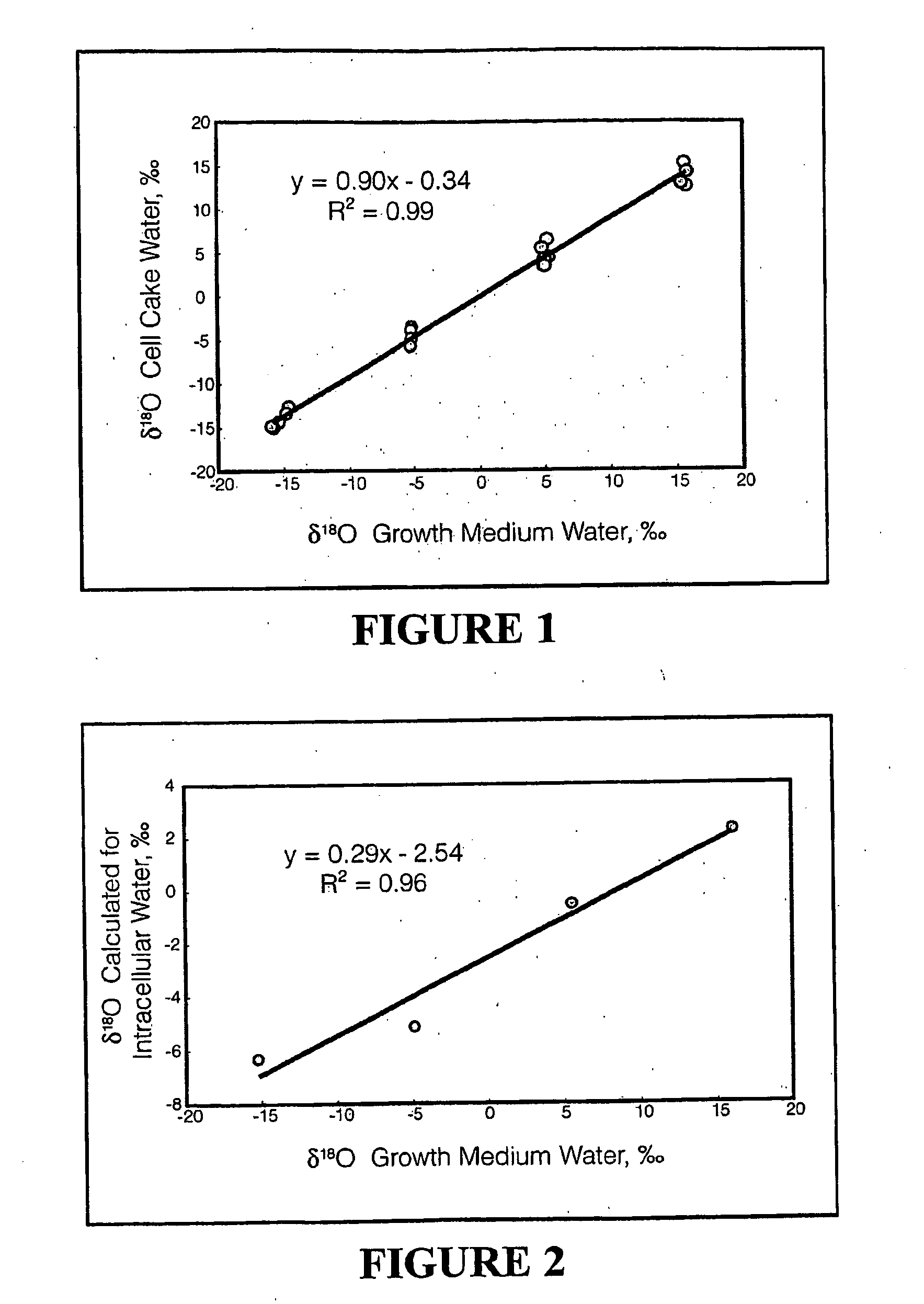Isotope Detection and Uses Thereof
a technology of isotopes and isotopes, applied in the field of isotope detection, can solve the problems of no current method for measuring the metabolic activity of a single cell or a small group of cells
- Summary
- Abstract
- Description
- Claims
- Application Information
AI Technical Summary
Benefits of technology
Problems solved by technology
Method used
Image
Examples
example 1
Oxygen Isotopes Indicate Most Intracellular Water in Log-Phase Escherichia Coli is Derived from Metabolism
Materials and Methods
[0068]Cultures: E. coli BL21 (DE3) cultures were grown in 2×Miller Luria-Bertani (LB) broth (EMD Chemicals) at 37° C. with shaking at 225 rpm. The culture volume was one-tenth the flask volume. The 2××LB contained 20 g tryptone, 10 g yeast extract, and 20 g NaCl per liter and had an osmolality of 838 mosmol / kg, as measured on a Wescor 5500 vapor pressure osmometer. Batches of LB were made with isotopically varying water.
[0069]To determine the optical density readings associated with mid-log phase, growth of cultures were monitored in 2×LB, regular absorbance measurements taken at 600 nm on a Hach Odyssey spectrophotometer. Mid-log phase was associated with OD600 readings of 0.8 to 1.0 and a doubling time of approximately 30 minutes. Stationary phase cells were harvested about 12 hours after inoculation, when the OD600 of a 1:10 dilution of the culture had be...
example 2
Metabolic Processes Account for the Majority of the Intracellular Water in Log-Phase Escherichia coil Cells as Revealed by Hydrogen Isotopes
[0089]Cell Cultures: E. coli BL21 (DE3) cultures were grown in 2×Miller Luria-Bertani (LB) broth (FMD Chemicals) at 37° C. to either mid-log or stationary phase. The cells were then collected via filtration, transferred to a vial, sealed and frozen. Water was then extracted cryogenically from the cell pellets and spent medium samples. The desiccated cell pellets were stored at room temperature prior to lipid extraction.
[0090]Fatty Acid Extraction and Analysis: Fatty acids were extracted from desiccated cell pellets, such as those prepared in Example 1, by saponification and then converted to methyl esters for structural analysis by gas chromatography / quadrupole mass spectrometry (GC-MS) and for isotope ratio measurements by gas chromatography-isotope ratio monitoring mass spectrometry (GC-IRMS). The extraction and methylation were performed in g...
example 3
[0128]FIG. 8 illustrates data from experiments with eight different lab rats. Four of the lab rats were raised on Salt Lake City (SLC) tap water and the remaining lab rats were raised on slightly enriched water. Five different tissue samples were collected from each of the four rats. From the animals grown in slightly enriched water it can clearly be seen that the blood water has a very different isotope value for both O and H than the tissue water. The lab rats grown on SLC tap water follow the same trend but the values are much closer to each other (and are not separately labelled on this graph). This suggests that the isotope ratio of the metabolic water is reasonably close to that of SLC tap water. In the case of hydrogen, the signature of the food and tap water were similar thus masking the difference between metabolic water and extracellular water. Note, however, that tap water in other locations, such as, for example, Houston, can have different isotope ratios.
[0129]FIG. 9 il...
PUM
 Login to View More
Login to View More Abstract
Description
Claims
Application Information
 Login to View More
Login to View More - R&D
- Intellectual Property
- Life Sciences
- Materials
- Tech Scout
- Unparalleled Data Quality
- Higher Quality Content
- 60% Fewer Hallucinations
Browse by: Latest US Patents, China's latest patents, Technical Efficacy Thesaurus, Application Domain, Technology Topic, Popular Technical Reports.
© 2025 PatSnap. All rights reserved.Legal|Privacy policy|Modern Slavery Act Transparency Statement|Sitemap|About US| Contact US: help@patsnap.com



